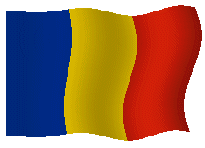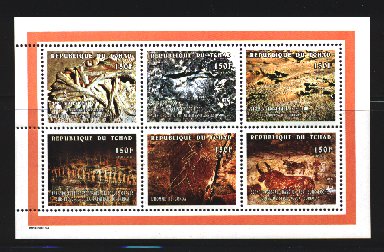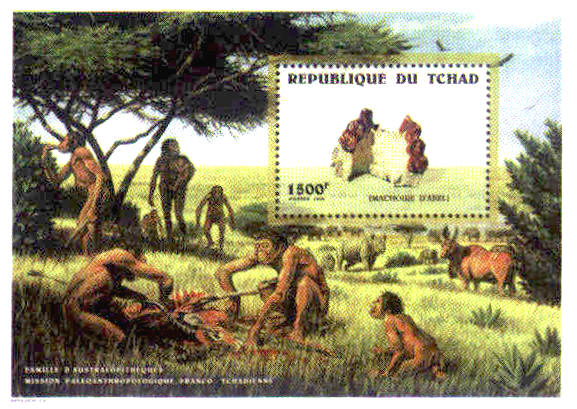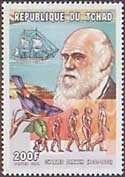
CHADE
THE FRAUD OF THE CHADE
1966
« Tchadanthropus uxoris »
Not a prehistoric skull
30 Fr.,
Tchadanthropus uxoris (=Homo erectus) skull.
Issue date: 20-th of September.
Scott: 133.
Stanley Gibbons: 162.
Yvert nº. 131
![]()
The first 'early hominid' from Chad, Tchadanthropus uxoris, found in 1961, turned out to be the face of a modern human skull that had been so eroded by wind-blown sand that it mimicked the appearance of an australopith, a primitive type of hominid. The second Chad hominid, Australopithecus bahrelghazali, discovered at a site called Koro Toro in 1995, is an authentic australopith and alerted palaeontologists to the potential of central West Africa.
![]()
BIOLOGY
THE HOAX OF THE CHADE
The Miss Yves Coppens finds in 1965, in Yayo, the north of the Chad, not in situ, a face of an «hominiidae» extremely rolled, with widened to occult the nasal orifices.
Yves Coppens described them as a new Australopithecus under the assignment of " Tchadanthropus ".
This vestige, excessively fragmentary, does not present the australopitheciidae characters and seems a recent form of retouched man,that as suggests the fauna and the flora formation who involved it, and he dating of C14 .
The known fossil record of hominids, also showing ourselves (top left) and the chimpanzee (top right).
![]()
Man by the Gonoa
The expedition team of globetrotter SELECT will kidnap you by harmful landscapes into the Tibesti Mountains. Over 3000 m high volcanoes, torn crater, enormous Caldera, hidden oases, truely wild, almost volcanic mountains in the midst of enormous sand seas let the reasons for the isolation and unexplored ness of the heart of the Sahara suspect very fast. We will you the inhabitants of the Tibesti, when fearless, predatory and very strange-hostilely described, present, you beside the " Man by Gonoa ", rock painting and engravings from the Neolithic, newly discovered to show and it at unbelievable variety at forms and colors be astonished to let!
1998
Mission Paléoanthropologique Franco-Tchadienne (M.P.F.T.)
Set up and led by Michel Brunet since 1994, the Mission Paléoanthropologique Franco-Tchadienne is a scientific cooperation between the University of Poitiers, the University of N'Djamena, and the Centre National d'Appui à la Recherche of N'Djamena.
![]()
Homo sapiens neanderthalensis
Abel ?
Dorothy Annie Elizabeth Garrod (1892-1969)
Anthropologist
Born in 1892, Dorothy Annie Elizabeth Garrod was the daughter of an English physician. She studied at both Newnham College Cambridge starting in 1913, and later Oxford University under Abbe Breuil, where she studied Paleolithic France. Garrod did fieldwork in England, Palestine, Kurdistan, Bulgaria, Gibraltar and Lebanon. She spent considerable time at excavations in the Near East, her most notable being twenty-two months at Mount Carmel. The Mount Carmel cave sites covered over two hundred thousand years of occupation. There she found thousands of stone tools and many Neanderthal skeletons. This excavation is regarded as a pioneering effort as no Neanderthal skeletons had been discovered outside of Europe till this time.
Garrod found the first Neanderthal skeleton from outside of Europe here, in addition to ninety-two thousand stone tools. The female Neanderthal’s skeleton led her to discover ten more, consisting of men, women and children. She was able to conclude that Neanderthals in Europe and the Near East existed at the same time, though the ones in Europe were more primitive. This, of course, caused some excitement (not all good), as it didn’t relate to the currently popular theory of linear evolution. Garrod studied the remains of fauna of various areas, and was able to relate them clearly to ancient climatic and ecological conditions. She made major advances in a number of areas, as well, including Paleolithic art, prehistoric migrations of man, prehistoric irrigation methods, prehistoric hunting techniques and others.
![]()
2001
200 F., Portrait of Ch. Darwin, ship (the
'Beagle'?), bird, hominid evolution sequence.
Same stamp in M.S., with birds and fennec in margin.



